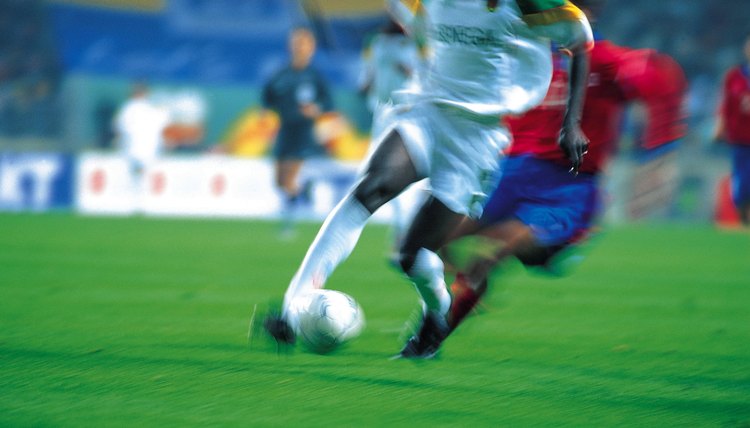How Does a Professional Soccer Player Spend a Workday?

Every part of a professional soccer player’s workday points toward the typical weekend league match, as well as some midweek games in the case of elite national team members who double up with regional championships or friendly matches, World Cup qualifiers and the World Cup Finals. Nutritious food and adequate rest play as much of a role as physical, technical and tactical training. A minor league professional won’t have quite the level of massage therapy and injury rehabilitation, though, as a cossetted pro at a major European club like Barcelona or Arsenal, whose every need is carefully attended to.
Warming Up
At the top levels, a pro soccer player arrives at the training facility at around 8 a.m. He may have breakfast there, followed by a light warmup on a training bicycle. The player may schedule time for a massage or visit to the physical therapist to check on any nagging injuries or to get taped up. The New England Revolution, for example, has players spend about 30 minutes activating problem areas, such as hips and low backs, followed by single-leg exercises to check for imbalances and to warm up their calf muscles.
Training
Two hours of training, or possibly two and a half hours, typically start around 10 a.m., usually five days a week. The coaches tinker with each workday schedule to achieve a different focus and goals. Three days each week may include a strength workout inside the team gym -- the Revs favor jump squats and kettlebell swings, as well as medicine ball slams and explosive pushups, for example. One or two days include agility and acceleration work, likely outside on the playing field, weather permitting. Technical work includes drills designed to help goalkeepers handle every kind of shot, and help field players improve passing, trapping, heading and shooting. Tactical drills may see players working on crossing in front of the goal, finishing -- in others words, completing shots -- and chaining up multiple passes.
Fitness and Playing
Small-sided games, with fewer than 11 players per side going all out for about five minutes, help players further hone their techniques and tactics, as well as encourage their cardiovascular fitness. Conditioning coaches also schedule timed sprints and suicide drills, with elite programs studying data from player heart-rate monitors -- as well as cleat monitors -- to gauge progress. The German national team, for example, fine-tunes each player’s fitness program based on data inputs of miles run, movements, heart rate and speed. Full 11-a-side practice games replicate game conditions. And in-season, players focus at least one day a week on an actual league or national team match.
Everything Else
Sunday, or whatever day falls after a match, will be a rest day for most pros, although some teams such as Southampton FC designate Sunday as a light workout day and move the rest day to midweek. Players take sleep seriously too, with the German team encouraged to move electronics out of the bedroom. The workweek also includes days devoted to travel to away games, as well as time slots for media interviews, personal appearances and charity events.
References
Writer Bio
An award-winning writer and editor, Rogue Parrish has worked at the Washington Post, the Baltimore Sun and at newspapers from England to Alaska. This world adventurer and travel book author, who graduates summa cum laude in journalism from the University of Maryland, specializes in travel and food -- as well as sports and fitness. She's also a property manager and writes on DIY projects.
